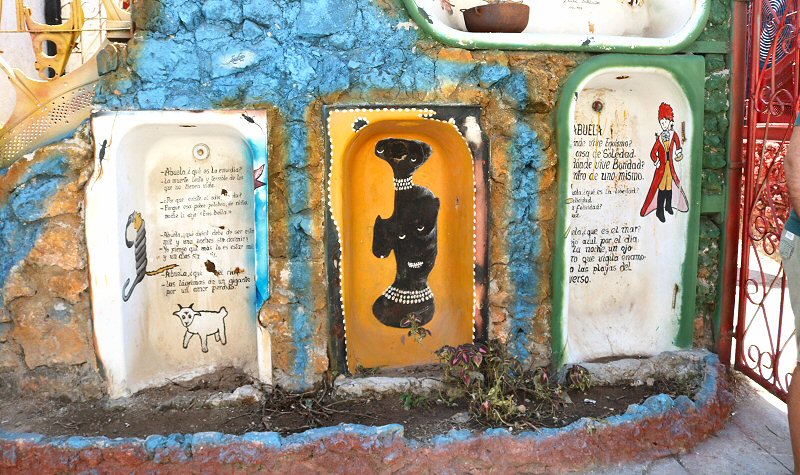

In the district of Vedado in Havana, an alley, known as the Callejón de Hamel, has been converted into an open exhibition area of the Afro-Cuban culture that has also a cultic monumental character. The term Afro-Cuban was used for the first time by the famous Cuban ethnographer Fernando Ortiz.
The change in the alley started, when the Cuban painter, sculptor and muralist Salvador González Escalona that describes his Afro-Cuban style as a mix of surrealism, cubism, and abstract art, painted a mural at the wall of the house of his friend in 1990. This set off a reaction, in that some neighbors joined him. Not long after his first mural, his works started spilling out onto street and up the sides of the buildings. In the first four years of his work in the alley, the residents of the alley encouraged him, as his objective was to bring the creativity in art of the ordinary people to light. Who would not want to revitalize this desolate backstreet, forgotten by the time, and transform it to an art gallery, unique in its kind !!? He used different kind of objects to create his sculptures, such as bathtub, hand pump, pin wheel, industrial machinery, construction rubble and animal bones and used several kinds of paint, including car polish. Day by day the alley changed to a vivacious art center, where Cuban children received education in workshops and trained in rumba dances, accompanied by Cuban music, and a space in that the art and the community interacted. The activity in the alley began as a simple street exhibition of Afro-Cuban art, but in the course of time the alley became a reference point of the Afro-Cuban art and culture, and a kind of sanctuary for all Cubans that feel deeply bound up with their roots that are still alive.
The name of alley comes from the wealthy trader Fernando Belleau Hamel that was a US citizen of Franco-German origin. He bought some land in the current neighborhood Cayo Hueso (Key West) at the end of the 19th century, and he was living there. The neighborhood Cayo Hueso, recognized officially in 1912, lies to the northwest of the Centro Havana, bordered by the Malecón, the Zanja, the Padre Varela and the Infanta streets. He was known by giving work to the blacks and the Chinese people in his foundry. He constructed many houses in this region; thus, he became the richest man in the area that took the entire underprivileged district into his possession. The attempt of the government to buy his land in 1913, was unsuccessful. His surname was given to the alley by courtesy.
The alley stretches two blocks, but
the vital part lies at its eastern end, just right next to a
secondary school. The alley is filled with all kind of
visual arts like paintings, mosaics, sculptures and
unclassified objects. The murals that adorn the humble
buildings represent the religious and cultural syncretism of
the island. The brightly colored paintings reproduce the
Orishas, the Santería kings. The paintings contain some
spiritual and animal symbols, decorative figures and images,
and also some verses and famous quotes about life, love and
humanitarian values like dignity. The artists transformed
unusual materials into art. You can find many interesting
works in the alley like the throne that bestows good luck
and the bench made of old bathtub. Old bicycles are used to
create an artwork.
For the tourists, the venue became
a place to experience the Afro-Cuban culture, as well as an
open market where products of this culture, like the hand
carved statues, paintings etc., are sold in tiny shops. At
the end of the alley, there is a small café with a few
stools featuring a studio workshop where some art pieces,
done by González, are sold. The success in attracting the
tourists made the place a little bit commercial. Even though
the Cayo Hueso neighborhood once had a bad reputation,
visiting the Callejón de Hamel is safe for the tourists.
Even so, it is recommended to keep your belongings with you
and keep an eye open for the purse snatchers, particularly
while enjoying the specialty drinks and dancing with
performers.
The Callejón de Hamel is also a
venue for Santería ceremonies and mini street festivals. If
you are a fan of rumba, or would like to get acquainted with
it, the best time to visit the place is on Sundays between
11:00 and 15:00, when the Santería priests perform rumba
dance with tourists. Maybe the Callejón de Hamel is the best
place to witness a truly amazing performance of the rumba
rhythms, accompanied by the drums. The dancers shake their
hips and sway their arms and legs to the music, creating an
atmosphere to invoke the spirit of the Orishas. The
performances are free, but you will be asked to offer a
small donation.
In the alley, there is also a place
for a nganga (herbalist and spiritual healer in many African
societies), a sacred place for the celebrations of Palo
Monte belief.
In this alley many small concerts
were organized by important groups or outstanding musicians,
such as Merceditas Valdés, Celeste Mendoza, Yoruba Andabó, Clave
and Guaguancó and many more.
There are lights in the Callejón de
Hamel, but it is recommended to visit the place during the
day, as you may miss the fine details of the murals, when it
will be too dark.

The Callejón de Hamel is located
between the Aramburu and the Hospital streets, and runs parallel with the
San Lazaro street.